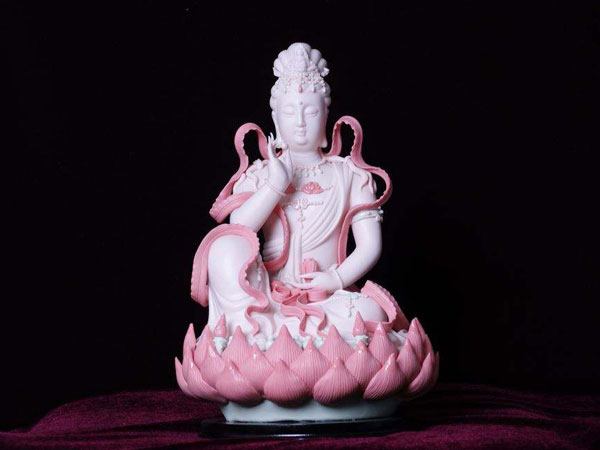For thousands of years, the carving of jade has been an intrinsic part of Chinese culture. The history of jade in China can be dated back to Shang Dynasty (16th century – 1066 BC) when jade was used as a medium of exchange.
History development
According to ancient Chinese people, jade had five distinctive characteristics, the so-called five virtues, including tough texture, crystal gloss, gorgeous colors, compact and transparent organization, clear and pleasant sound. Therefore, serpentine, turquoise, malachite, agate, crystal, amber and ruby were also considered as the jade.
Given its rich jade reserves and long history of producing jade, China has been one of the major jade producers in the world. Dating as far back as Neolithic Age and Bronze Age, people used simple tools of bamboo, wood, animal bones or sands tones to make beautiful jade wares. A batch of jade wares excavated from the Liangzhu Cultural Site in Taihu Basin and Hong Shan Cultural Site in Liaohe Basin reflect the jade craftsmanship and the cultural features of Neolithic Age.
Chinese jade
Shang Dynasty (16th century – 1066 BC) was not only renowned for the solemn bronze wares, but also a wealth of jade wares. 755 jade objects unearthed from the tomb of Fu Hao Yin ruins in Anyang can be classified into six categories: the sacrificial vessels, ceremonial items, jade articles of daily use, ornamental jades and other functional jade wares. Jade artisan began to use Hetian Jade and cave human-figure-shape jade and animal-shape jade. There were jade dragon, jade phoenix, jade parrot, and various types of jade carving human figures. The Chinese jade carving art of Spring and Autumn Period and Warring States Period (770-221 BC) was on par with the stone carving art in Rome and Greece of the same time.
Chinese Jade carving industry reached its heyday in late Qing Dynasty. Antique Chinese jade of Qing Dynasty are of fine quality, superb workmanship, various themes and functions, therefore are much favored by jade collectors.
Cultural meaning
In Chinese culture jade has its cultural meaning. Traditionally, Chinese people thought jade is the most precious stones, a sacred material that containing the quintessence of virtue. In the early times jade was confined to ritual purely ornamental objects such as the jewelry, dress accessories and items of personal adornment. In imperial times jade was regarded as a symbol of wealth and rank. It is widely believed by Chinese people that jade transmits its superior qualities to the one who wears it, wards off the evil and protect the wearer from misfortune. For this reason, jade bracelets are given to the children as an auspicious gift.
Chinese jade ware
Characters of Chinese jade
Chinese jade appears in nature in a great variety of ways. The jade carving industry in China now uses 30 types of jade and precious stones including nephrite, jadeite, lapis lazuli, turquoise, agate and malachite. The majority of Chinese jade is used to make jade articles and objects, with small amounts of best quality jade set aside for jewelry manufacture. Jade carving is one of the highest achievements in Chinese handicrafts. In ancient China, jade was revered and used as ritual objects notably for Buddhist figurines.
The most famous types of Chinese Jade
In terms of quality and texture, Chinese jade is divided between soft jade and hard jade. In terms of regional distribution. Chinese jade is from Xinjiang, Liaoning, Yunnan, Gansu, Shannxi, Shanxi, Beijing, Tibet, Qianghai, etc. The four most famous types of jade in China are Lantian jade, Nanyang jade, Xiuyan jade and Hetian jade.
Lantian Jade – Produced in Lantian Country, Shannxi Province, Lantian jade is non-transparent, of a yellow or light green color and belongs to the diopside category. Lantian people began to mine jade in Han Dynasty and craft numerous jade art works and treasures.
Nanyang Jade – The jade mine is located in Dushan Mountain, Nanyang, Henan Province, thus the jade is also named Du Jade. Nanyang jade belongs to anorthose category, of fine texture, vitreous luster,multi-color and good polishing performance.
Xiuyan Jade – It was so named because the jade was mined in Xiuyan, Liaoning Province. Xiuyan jade belongs to serpentine category, and usually has a turquoise or yellow green color. The area is now the major jade mine in China, which normally three-fifths of the country’s jade .
Hetian Jade – The Hetian jade resources mainly distribute in the north slope of Kunlun Mountain stretching 1500km from Shache to Tashkurghan and from Hetian to Khotan in Xinjiang. The main composition of Hetian jade is tremolite and actinolite.
Functions of Jade Ware
Jade is not a simple object, it’s an emotion for Chinese people. According to surveys, many famous ancient people had great passion to jade. And jade is endowed some special meaning by Chinese people. Many Chinese people think jade has power to drive away evil spirit. So it’s easy to see Chinese wear jade ware in the street. Jade is a natural mineral, containing full of trace elements, such as Zn, Mg, Cu, Co and so on. It’s even an important part of traditional Chinese medicine.
Chinese jade jewellery
How to maintain jade ware
1. Don’t crash with other objects. Jade is easy to crush, and crack will influence its’ beauty and value.
2. Try to avoid dust and greasy dirt. If there is dust on the surface of the jade, try to use soft brush to clean. If there is greasy dirt on the surface, please use soft soapy water to clean.
3. Try to avoid perfume, chemical reagent, and human sweat, which will corrode the jade.
4. Try to avoid exposing to direct sunlight for a long time. It’s easy to influence the jade’s quality.
Chinese jade ware





